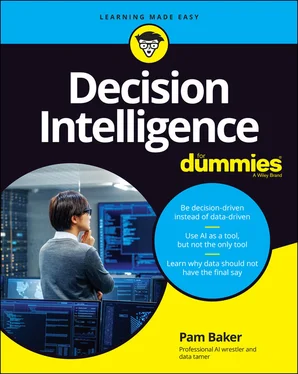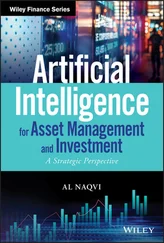Last but not least, the use of decision intelligence can also quickly build and accelerate career paths and turn decision masters into highly influential power brokers. All of these grand rewards come with varying degrees of risks, however.
No For Dummies book exists without The Part of Tens. In this part, you can read about ten (or so) steps to set up a smart decision and ten (or so) pitfalls to avoid in implementing decision intelligence projects.
Now and then, you find symbols in in the margins of this book. Their purpose is to make you aware of important information, as described here.
 This icon points to tips and tricks that should be helpful when you apply and implement an idea. They show you how you can improve your project.
This icon points to tips and tricks that should be helpful when you apply and implement an idea. They show you how you can improve your project.
 The Remember icon is used to highlight information that’s particularly important to know or that can help clear up possible confusion later.
The Remember icon is used to highlight information that’s particularly important to know or that can help clear up possible confusion later.
 This icon makes you aware of potential stumbling blocks and warns you when to not do something. If you avoid errors that others have made before you, you’ll save time, money, and effort.
This icon makes you aware of potential stumbling blocks and warns you when to not do something. If you avoid errors that others have made before you, you’ll save time, money, and effort.
In addition to the text you’re reading right now, this publication comes with a free, access-anywhere Cheat Sheet that offers a number of tips, techniques, and resources related to data science. To view this Cheat Sheet, visit www.dummies.com and type decision intelligence for dummies cheat sheetin the Search box.
You can start immediately by choosing one of these two strategies:
Read the book straight through, from cover to cover.
Find individual chapters that you want to read first. (Each chapter covers an entire subject area so that you can read and understand it independently of the other chapters.) If you have no experience with decision intelligence yet, I recommend starting with Chapter 1, which offers a crash course introduction to the concept.
My advice to you: Be aware that decision intelligence, though it has a firm definition, is used more loosely by several groups. For example, people working in AI most typically use it to mean putting the decision first in programming automation or training machine learning to make better automated decisions at scale. That’s an application rather than a definition, but its common use as such can cause some confusion over the meaning of the term in general reading. For the purposes of this book, decision intelligence is meant by its broader definition and not a single application. However, given its prevalence in AI, the applications there are covered in more detail than other forms of decision implementation. Therefore, I recommend that you read the Parts 1and 2first to ensure that you have a good grasp of the framework overall before touching on related topics in other parts or chapters.
Otherwise, experiment with the reading strategy that works best for you. Jump to different sections while you read this book, if that makes sense to you. If necessary, reread a chapter multiple times or look up individual terms in the index. The idea here is for you to come up with your own way to read this book effectively. And don’t forget to keep it nearby for quick-and-easy reference as needed while you work through your first few decision intelligence projects.
Part 1
Getting Started with Decision Intelligence
IN THIS PART …
Mining data verus minding the answer
Learn why math-only approaches are weak
Watching the details and missing the big picture
Discover the epiphany in the inverted V approach
Chapter 1
Short Takes on Decision Intelligence
IN THIS CHAPTER
 Becoming familiar with the decision intelligence approach
Becoming familiar with the decision intelligence approach
 Comprehending the method, principles, and priorities of decision intelligence
Comprehending the method, principles, and priorities of decision intelligence
 Working your way from design to reality
Working your way from design to reality
 Seeing the difference an inverted V makes
Seeing the difference an inverted V makes
 Implementing for the win
Implementing for the win
Do you find yourself looking at a spreadsheet or viewing charts or gazing glassy-eyed at a fancy visualization that some bit of artificial intelligence magic has produced for you and wondering what you should do next? You’re not alone. Millions of other business and finance people are doing the same thing. So are legions of leaders and decision-makers in other industries.
While you’re trying to puzzle out which parts of those “actionable insights” being handed to you are in fact actionable and, if so, what action would apply, you’ve likely wished for something a bit more cut-and dried when it comes to determining what your organization would implement — and you certainly wouldn’t mind being considerably more certain about what's going to happen post-implementation.
Would your best bet in such a situation involve letting the miracle of artificial intelligence (AI, for short) make your decisions for you? Well, it turns out that AI isn’t so miraculous. In fact, an estimated 80 percent of all AI projects fail, where failure here is defined in terms of failing to deliver a measurable business value. That means most AI projects end up on the trash heap for leaning too heavily on the experimental side and being useless on the applied side.
It is painfully (and expensively) obvious that this strategy isn’t quite working out the way everyone hoped. An alternative approach is needed to make data more helpful and better aligned with consistently delivering business value. One such approach flips the model from data driven processes to decision driven processes. Known as decision intelligence, human and machine decision-making skills are combined with decision theory, decision sciences, and data sciences in a customizable mix that pins decisions to a precise and expected business value.
The concept isn’t entirely new — one of its oldest published mentions cropped up in 2002 in Uwe Hanning's scholarly paper “Knowledge Management + Business Intelligence = Decision Intelligence” — but it has evolved over time, incorporating long-accepted scientific formulas from several well-established sciences. This means its inner workings are well known and tested. Switching over to a decision intelligence approach is therefore no gamble — it's simply a supremely logical way for you to achieve the business outcomes you desire. Decision intelligence leaves little to chance, in either its own construct or the value it consistently delivers.
Читать дальше

 This icon points to tips and tricks that should be helpful when you apply and implement an idea. They show you how you can improve your project.
This icon points to tips and tricks that should be helpful when you apply and implement an idea. They show you how you can improve your project. The Remember icon is used to highlight information that’s particularly important to know or that can help clear up possible confusion later.
The Remember icon is used to highlight information that’s particularly important to know or that can help clear up possible confusion later. This icon makes you aware of potential stumbling blocks and warns you when to not do something. If you avoid errors that others have made before you, you’ll save time, money, and effort.
This icon makes you aware of potential stumbling blocks and warns you when to not do something. If you avoid errors that others have made before you, you’ll save time, money, and effort. Becoming familiar with the decision intelligence approach
Becoming familiar with the decision intelligence approach










